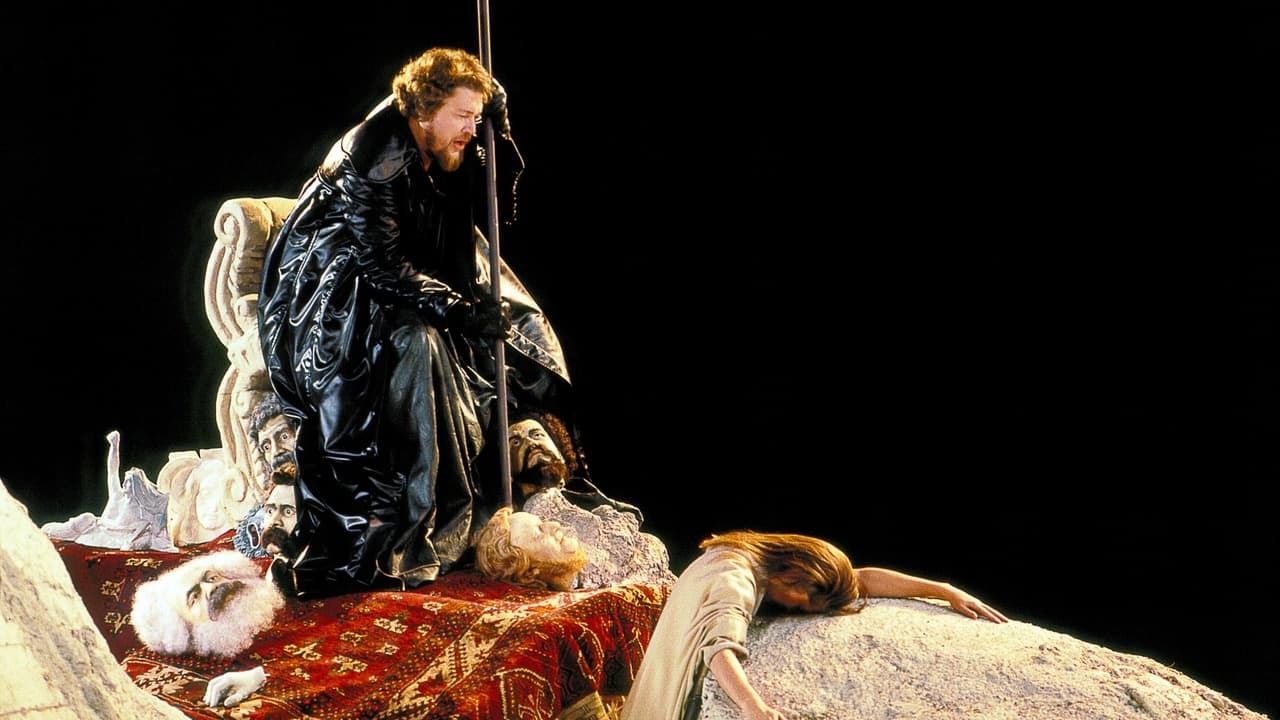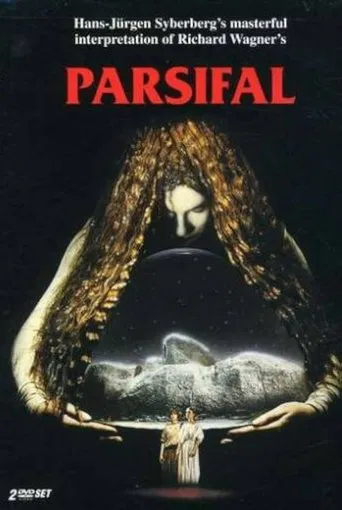

This very peculiar setting of Wagner's last opera definitely grew on me. When I first saw it, I was somewhat annoyed by many of the films surrealistic images, and felt that far too much was superimposed upon the story. However, if you can put up with a fair amount of rather recherché "gimmicks," I think you will find that the film DOES manage to capture the very strange, other-worldly atmosphere of the opera, and that there are moments which are particularly fine.Personally, I never really understood the role of Kundry until I saw how Edith Clever portrayed her. Her performance (a lip-synchronized mime of the singing voice of Yvonne Minton) is nothing short of dazzling, from end to end, and alone justifies the hours it takes to absorb the film.Another reason to delight in this film is that it captures the spectacular interpretation of Robert Lloyd of the crucial role of Gurnemanz, one which Lloyd has performed to a crisp at opera houses throughout the world. I have been privileged to enjoy him in the role of Gurnemanz on the stage of the Metropolitan Opera several times, and the lusciousness of his voice, and the warm, fatherliness of his interpretation of this noble character really needed to be preserved, as did his performance in the character's two major monologues, the Karfreitag scene and the recounting of the prophecy in Act 1.The version I have seen was a videotape made for America, and so there were subtitles which, alas, could not be done away with. This is especially unfortunate because the translation used is very inaccurate and forces an extremely Christian interpretation on a film which is already forcing layers of interpretation on the opera. This seemed to me to be quite contrary both to Wagner's clear AVOIDANCE of Christianity, and his very deliberate attempt to "generalize" the Christian elements of the story. (See footnote with spoiler at the end of this review.) I find it nearly impossible, when viewing a film with subtitles, to keep from absorbing them, and strongly recommend that, if in the DVD versions you have the ability to turn the subtitles off, you do so, and instead, if the opera is unfamiliar to you, that you read the libretto carefully beforehand.The bottom line is that there is much in the film which I dislike, and would just as soon have seen done differently...but it has risen steadily in my estimation over the years since I first saw it, and I find myself drawn to enjoy it again and again.__________________________________________________________________FOOTNOTE CONTAINING A SPOILER: A good example would be Kundry's famous line, "I saw him...him...and laughed." This gets translated, in the subtitles, for reasons which escape me, as "I saw the Savior's face." It is especially irritating to me, because throughout the libretto, Wagner very deliberately and carefully refers to this unseen character WHO NEED NOT BE THE BIBLICAL Jesus as "der Heiland," i.e., the German for "The Healer"--a reference to the wound of Amfortas, and to all wounds and maladies and the need for healing.
... View MoreBack when I saw this film when it came out first run at the local art theater, it blew me away. When I tried to get into it again after locating a DVD copy, I couldn't sit through it. Most of the trappings of Syberburg's much-vaunted style have the feel of artsy gimmicks of his hot period, the late 70s and early 80s. The puppets, which are part of this scene, don't bother me half as much as the projection of images over everything on stage, and the shifting video slide show backgrounds. This technique seems to have been a solution that Syberburg believed in deeply-- and to feel he was leading the avant pack in using. But a solution to what, I'm not sure. To break up basically static tableau setups, yes. To speak to the wide-wandering emotional interior state of the films participants, certainly. But why make the film auditorium-bound in the first place if it's restless, ceaseless movement you crave? --Budget limitations? --Because you feel challenged or amused tinkering around with active/static dynamics? Either of these reasons is acceptable to me, but I don't find the fruit of this experimentation especially successful, or more, very durable.The music is great, and I DO yearn for something more eccentric or intense than the standard PBS/Met production with guys standing around bellowing in obvious crepe whiskers and stage dirt. But this film goes arty in a way that doesn't speak to many people any more, and as far as I'm concerned, it way overshoots the crazed artist mark. A little less please.
... View MoreWhile lovers of Parsifal may be considered a minority, those of us who like Syberberg's film might be rarer still!Of the title character Wagner wrote to Mathilde Wesendonk:"Parsifal must carry the interest of a major character if he is not arrive at the end as a deus ex machine . . . (his) development must be brought back to the foreground and for this I have no option, no broad scheme such as Wolfram could command; I must so compress it all into three main situations of drastic substance that the profound, ramifying meaning is presented clearly and distinctly."With "drastic" and "distinctly" in mind, Syberberg's use of both male and female actors as Parsifal seems to me a brilliantly cinematic means of achieving the result Wagner was after.Every era believes itself to be a superior civilization to those prior to it and, if for no other reason than having distance and evolution on its side, the assumption has some credence. In this regard, Wagner saw himself as being somewhat benevolent in his forgiveness of Wolfram whom he admired (obviously) but viewed as a product "of a barbaric and utterly confused age." Nonetheless - with irony unintended - Wagner ridicules Wolfram, calling him on his irresolute nature in the poem, his ideals wavering between the purely pagan and those of a strong Christian nature (as though either of these are mutually exclusive - as I always say, Jesus and Santa Claus keep each other in business).This irony actually hits with full force since Wagner himself substituted Wolfram's Grail with the chalice which Joseph of Arimethea caught the blood of the crucified Jesus, thus altering the Grail Hall ceremony of Wolfram's "barbaric" paganism into a ritual unmistakably and obviously (right down to its text) Christian. (This, by the way, served to further drive the stake between Wagner and Nietsche's once very strong friendship.)I like Syberberg's use of Third Reich imagery in the Act I transformation music. Initially it horrified me (to the point of my eyes popping out of my head and my flesh getting all clammy-cold). Like Wagner changing Wolfram to suit his dramatic needs without changing the actual shape of the tale's intent, Syberberg's arresting imagery here - in a matter of only minutes - pulls together a history into a quick, timely shock of recognition that hits squarely and which burns its imagery forever into the mind.I agree with some critics that fetishization is not too strong a term to describe what Syberberg does in his film. Certainly Amfortas' own endless proclamations of his guilt and unworthiness can be recognized in all of us to varying degrees - Wagner's (and Syberberg's art merely expanding this. Here (I'm not sure why) I often find myself thinking of Penelope; wearing her mournful chastity for Odysseus for twenty years, and that noble mourning eventually takes on other qualities; although still admirable also smacks of arrogance: self-induced martyrdom. Even so, it does not fundamentally diminish the character's integrity or original intent. Rather it complicates the person, adding endless facets - as well as a blatant human face - to that which may outwardly appear simple - but makes us aware there is far, far more.I love this movie, but certainly can understand those who find it difficult (if not impossible) to warm up to it. Give it another chance! It may just grab you.p.
... View MoreIt must be assumed that those who praised this film ("the greatest filmed opera ever," didn't I read somewhere?) either don't care for opera, don't care for Wagner, or don't care about anything except their desire to appear Cultured. Either as a representation of Wagner's swan-song, or as a movie, this strikes me as an unmitigated disaster, with a leaden reading of the score matched to a tricksy, lugubrious realisation of the text.It's questionable that people with ideas as to what an opera (or, for that matter, a play, especially one by Shakespeare) is "about" should be allowed anywhere near a theatre or film studio; Syberberg, very fashionably, but without the smallest justification from Wagner's text, decided that Parsifal is "about" bisexual integration, so that the title character, in the latter stages, transmutes into a kind of beatnik babe, though one who continues to sing high tenor -- few if any of the actors in the film are the singers, and we get a double dose of Armin Jordan, the conductor, who is seen as the face (but not heard as the voice) of Amfortas, and also appears monstrously in double exposure as a kind of Batonzilla or Conductor Who Ate Monsalvat during the playing of the Good Friday music -- in which, by the way, the transcendant loveliness of nature is represented by a scattering of shopworn and flaccid crocuses stuck in ill-laid turf, an expedient which baffles me. In the theatre we sometimes have to piece out such imperfections with our thoughts, but I can't think why Syberberg couldn't splice in, for Parsifal and Gurnemanz, mountain pasture as lush as was provided for Julie Andrews in Sound of Music...The sound is hard to endure, the high voices and the trumpets in particular possessing an aural glare that adds another sort of fatigue to our impatience with the uninspired conducting and paralytic unfolding of the ritual. Someone in another review mentioned the 1951 Bayreuth recording, and Knappertsbusch, though his tempi are often very slow, had what Jordan altogether lacks, a sense of pulse, a feeling for the ebb and flow of the music -- and, after half a century, the orchestral sound in that set, in modern pressings, is still superior to this film.
... View More